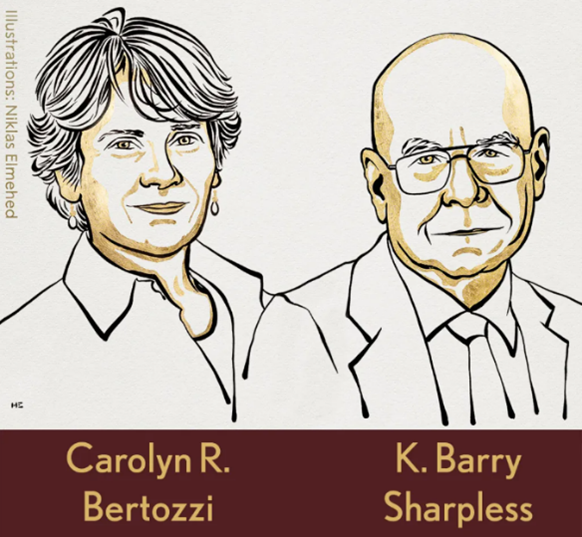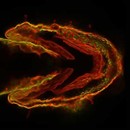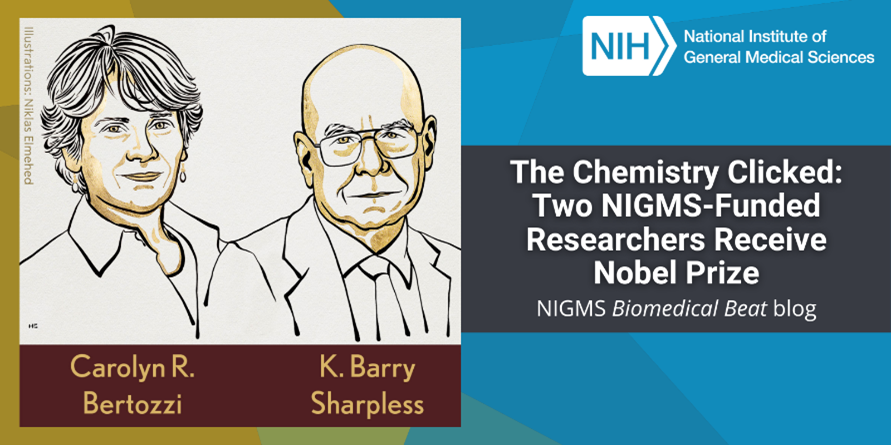Since its creation in 1962, NIGMS has supported the work of the recipients of 94 Nobel Prizes—44 in physiology or medicine and 50 in chemistry. NIGMS-funded investigators perform cutting-edge basic research that is foundational to understanding normal life processes and disease. Such important breakthroughs in chemistry and biology often fuel more focused research that, years later, leads to important medical advances or products such as medicines or biotechnology tools.

The most recent NIGMS-supported Nobel laureates are Carolyn R. Bertozzi, Ph.D., the Anne T. and Robert M. Bass Professor in the School of Humanities and Sciences at Stanford University in Stanford, California, and K. Barry Sharpless, Ph.D., the W.M. Keck Professor of Chemistry at the Scripps Research Institute in La Jolla, California. They, along with Morten Meldal, Ph.D., a professor of chemistry at the University of Copenhagen in Denmark, are being recognized with the 2022 Nobel Prize in chemistry for their work on a transformative scientific approach known as “click chemistry.” The three scientists will receive their awards during a ceremony in Stockholm, Sweden, on December 10, 2022.
Creating and Expanding Click Chemistry
Click chemistry enables researchers to snap together molecular building blocks as if they were LEGO pieces, often forming hybrid molecules with easy-to-track imaging agents attached. Not only has click chemistry expanded our ability to explore the molecular foundations of biological processes, but it has provided us with new tools for developing medicines, diagnostics, and other materials.
Dr. Sharpless is being recognized for his groundbreaking studies in the mid-1990s with click chemistry, a term that he coined. His initial work established click chemistry as a fast and reliable way to attach molecules. He and Dr. Meldal then independently introduced a copper-catalyzed click reaction that further refined the chemistry and helped popularize it across biology and the material sciences. The 2022 Nobel Prize is Dr. Sharpless’ second; he received his first in 2001 for the discovery of asymmetric catalytic reactions.
Dr. Bertozzi is being recognized for expanding the use of click chemistry with bioorthogonal chemistry, which is a copper-free version of the approach that can be used inside living cells without the risk of metal-associated toxicities. Bioorthogonal chemistry has enabled Dr. Bertozzi and other researchers to label glycans—carbohydrate molecules that coat the surfaces of our cells and most secreted proteins—and visualize them in a range of cells and living organisms.

Glycans are essential to life and, in higher organisms, play fundamental roles in processes such as metabolism, immunity, and cellular communication. They also are poorly understood, largely because they were difficult to study with traditional techniques. Since Dr. Bertozzi introduced bioorthogonal chemistry in the early 2000s, it has become an essential tool in labs that study glycans, leading to stunning discoveries that would have otherwise been difficult or impossible to achieve.
Impacts on Health and More
For clinical researchers, click chemistry has emerged as a workhorse in drug discovery and the improved targeting of cancer chemotherapies and other small-molecule drugs. The approach also is being used to improve the delivery of antibody-based therapies and to create new biomaterials. Meanwhile, in the material sciences, click chemistry has solved problems in working with polymers and expanding their industrial uses.
Click chemistry is an excellent example of how advances in basic science can build the foundation for a wide range of practical applications, including those aimed at improving human health. It also highlights the value of strong, sustained public funding for fundamental research: NIGMS has supported Dr. Sharpless continually since 1975 and Dr. Bertozzi since 1999.
Dr. Bertozzi’s research is currently funded by NIGMS grant R01GM058867, as well as by the National Cancer Institute and the National Institute of Allergy and Infectious Diseases. Dr. Sharpless’ work is currently supported by NIGMS grant R01GM117145.







